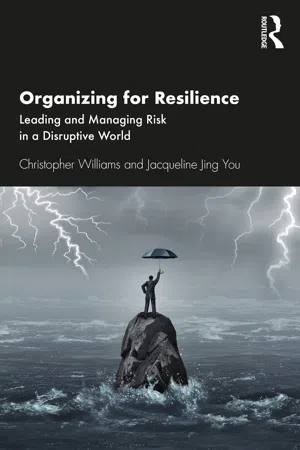
Organizing For Resilience
Leading and Managing Risk in a Disruptive World
- 304 pages
- English
- ePUB (mobile friendly)
- Available on iOS & Android
Organizing For Resilience
Leading and Managing Risk in a Disruptive World
About this book
Organizing for Resilience provides a fresh and novel insight into research on how leaders can prepare their organizations to face up to shocks and disruptions in a turbulent and unpredictable world. It provides an analysis of the topic of organizational resilience in a comprehensive and integrative way, with fresh theoretical and research implications as well as important implications for leaders.
The first book to synthesize themes from across a spectrum of resilience using the metaphor of a 'resilience landscape', chapters in Part I are devoted to five analytical levels: individual level resilience; small firms in which major disruption can threaten survival; large firms with disruptions in one part of the organization; large firms facing enterprise-wide disruption; and disruption to a complete community or economic ecosystem of individuals and organizations. Cases and practice insights are presented to bring the topics to life, allowing reflection and debate at each level. In Part II, the construct of the 'resilience landscape' is developed, along with a discussion on leadership for resilience by instilling a resilience mind-set and developing capabilities in relational resilience.
The book is ideally suited to bachelor's and master's degree courses on strategy, organizational behaviour and leadership. PhD and DBA researchers in the field of resilience and strategy will also find the book useful, as will practising consultants and business leaders.
Frequently asked questions
- Essential is ideal for learners and professionals who enjoy exploring a wide range of subjects. Access the Essential Library with 800,000+ trusted titles and best-sellers across business, personal growth, and the humanities. Includes unlimited reading time and Standard Read Aloud voice.
- Complete: Perfect for advanced learners and researchers needing full, unrestricted access. Unlock 1.4M+ books across hundreds of subjects, including academic and specialized titles. The Complete Plan also includes advanced features like Premium Read Aloud and Research Assistant.
Please note we cannot support devices running on iOS 13 and Android 7 or earlier. Learn more about using the app.
Information
PART I
LOOKING BACK
1
INTRODUCTION
The suffering factor: why care about organizing for resilience?
Can we control resilience?
Table of contents
- Cover
- Half Title
- Title Page
- Copyright Page
- Dedication
- Contents
- Preface
- PART I Looking back: research and cases of adversity and resilience
- PART II Looking forward: resilience in and for the future
- References
- Index